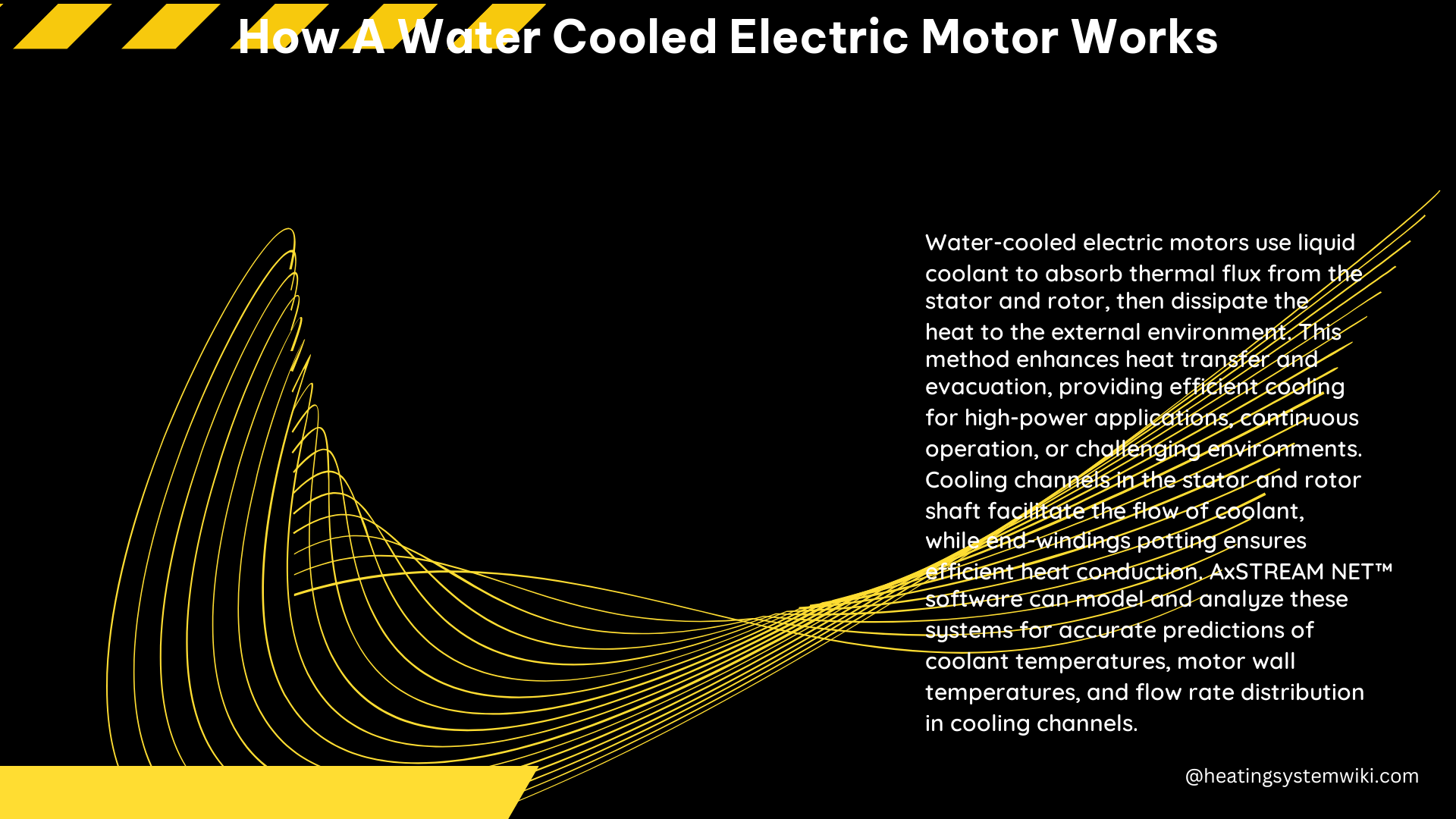Water-cooled electric motors are a highly efficient and compact solution for various industrial applications, offering superior heat dissipation and allowing for high power density. These motors work by circulating water around the hot parts of the motor, then pumping it into a radiator where large amounts of air can be passed over it, increasing the cooling efficiency.
Understanding the Cooling Mechanism
In a water-cooled motor, the coolant (typically water or a water-glycol mixture) flows through the stator and shaft cooling channels to absorb the thermal flux generated by the motor’s operation. The external environment, such as the surrounding air, acts as a heat evacuation medium, dissipating the absorbed heat.
The coolant flows axially from the front to the rear of the motor, improving the heat transfer from the motor cavities to the coolant directly through the lateral surfaces. In the rotor shaft, the cooling channel has a circular cross-section, with the coolant flowing axially along the motor’s rotation axis from the front to the rear of the motor shaft.
Coolant Flow and Heat Transfer
The coolant flow rate and temperature rise are critical factors in the cooling efficiency of a water-cooled electric motor. Typically, the coolant flow rate ranges from 2 to 10 liters per minute, depending on the motor size and power output. The temperature rise of the coolant, from the inlet to the outlet of the motor, is usually between 5°C to 15°C.
The heat transfer coefficient between the motor components and the coolant is a key parameter that determines the cooling effectiveness. This coefficient can range from 500 to 5,000 W/m²·K, depending on the coolant flow rate, motor design, and other factors.
Thermal Management Considerations
Water-cooled motors are designed to maintain the winding and rotor temperatures within safe limits, typically below 155°C for Class F insulation and 180°C for Class H insulation. The cooling system is engineered to dissipate the heat generated by the motor’s electrical and mechanical losses, which can range from a few kilowatts to several megawatts, depending on the motor size and application.
The thermal management of water-cooled motors also considers the ambient temperature, which can affect the cooling system’s performance. In high-temperature environments, additional cooling measures, such as heat exchangers or chilled water systems, may be required to maintain the desired operating temperatures.
Advantages of Water Cooling

Water-cooled electric motors offer several advantages over air-cooled counterparts:
- High Power Density: The efficient heat transfer from the motor to the coolant allows for a higher power output in a compact installation footprint.
- Reduced Noise and Vibration: The absence of cooling fans eliminates the associated noise and vibration, making water-cooled motors suitable for noise-sensitive environments.
- Dust and Moisture Protection: The smooth outer surface of water-cooled motors prevents dust buildup, and tight seals stop moisture and dust from entering the enclosure, improving reliability and reducing maintenance.
- Flexibility and Customization: Water-cooled motors are highly customizable, with options for bearings, insulation class, sensors, lubrication systems, terminal boxes, painting systems, and installation configurations.
- Remote Monitoring and Diagnostics: Water-cooled motors can be integrated with digital services, enabling remote condition monitoring and online documentation for predictive maintenance and improved operational efficiency.
Applications of Water-Cooled Electric Motors
Water-cooled electric motors are used in a wide range of industrial applications, including:
- Marine Thrusters: Providing propulsion for ships, boats, and other marine vessels.
- Winches: Powering winches used in various industries, such as construction, mining, and offshore operations.
- Pumps: Driving industrial pumps in applications like water treatment, oil and gas, and chemical processing.
- Cement Conveyors: Powering conveyor systems in cement production facilities.
- Extruders: Driving extruders in the plastics, rubber, and food processing industries.
- Clean Room Environments: Offering a solution for clean room applications where air disturbance must be minimized.
Conclusion
Water-cooled electric motors are a highly efficient and versatile solution for a wide range of industrial applications. By leveraging the superior heat transfer capabilities of water-based cooling, these motors can deliver high power density, reduced noise and vibration, and enhanced protection against dust and moisture. With their customizable design and compatibility with digital services, water-cooled motors continue to play a crucial role in modern industrial automation and machinery.
